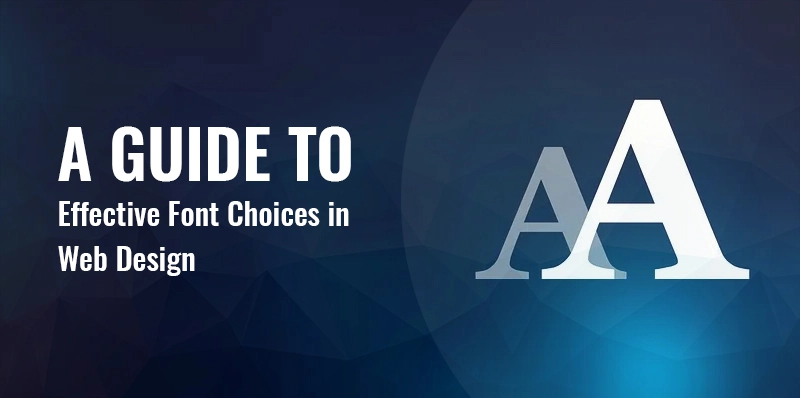Web design is more than just having a visually appealing layout. It encompasses various factors that enable brands to provide the best online experiences to their visitors. To do that, they must implement multiple elements in their overall design.
Table of Contents
These include responsiveness, accessibility, navigation, and one of the most essential aspects, which we will discuss in this guide, typography.
Typography goes beyond choosing a specific font and adding text to a white space. It’s a crucial technique expert designers leverage to make their websites user-friendly and aesthetically pleasing.
To help beginner designers and new startups, we’ve prepared a comprehensive guide on typography below, particularly when selecting the best right fonts. Discover the best practices when implementing the best ones in your web design and other crucial information.
The Importance of Typography in Web Design
Typography is the skillful use of fonts, spacing, and text layout to convey a brand’s message effectively and creatively. Implementing the best typefaces and font styles has the power to show warmth, exert authority, and other desired emotions that brands want to leverage to influence their target audience’s view of them. That’s why practicing excellent typography is among the crucial first steps in developing websites and apps.
Moreover, typography is a crucial practice that increases a site’s user-friendliness. With the proper techniques, designers can ensure visitors engage more with a website through its written content. If online users find the copy clear, legible, and digestible, there’s a high chance that they will stay to learn more, reducing bounce rates and increasing the chances of conversion.
Best Practices To Consider and Mistakes To Avoid When Choosing Fonts
One of the many essential aspects of typography is selecting the right fonts. This area goes beyond finding the ones that fit the overall layout. There are specific techniques that designers must practice to ensure that their desired typefaces enhance readability, capture branding, and boost a visitor’s overall experience.
With that, we’re discussing the know-how on picking the best fonts for your web design. We will provide crucial information, like tips to consider, mistakes to avoid, and more.
Limit the number of fonts
A golden rule of basic typography is to avoid adopting multiple fonts in a single design. Too many fonts will make the whole text look cluttered, disorganized, and unprofessional. For an excellent finish, designers must limit their fonts to at least two or three typefaces. Any more than that will overwhelm and confuse the visitors.
Related Post: Secrets to Optimizing Web Fonts to Reduce Loading Time
Opt for standard fonts
Many beginners steer clear of standard fonts like Arial, Helvetica, and Gotham because of how common they are. However, experts use many of these customary options because they’re designed to increase readability and are likely optimized for web use. It’s also worth noting that online users respond well to these fonts because they feel familiar.
Fortunately, many of these typefaces provide different styles. That means designers can create versatility while achieving the benefits mentioned above. Open Sans, Garamond, and Yellowtail are some of the best font families, offering numerous styles that designers can play with for a creative finish.
Avoid using all-caps
Using all-caps in your copy is a big no-no in web design. They provide a sense of aggression that instantly eliminates a layout’s user-friendliness. Plus, they make blocks of text difficult to read.
The only acceptable way to leverage all caps is to use them for titles and logos. If designers want to highlight a specific point in their copy, they must employ other formatting techniques like putting the text in bold or italics.
Use adaptable fonts
Online users visit websites on multiple devices with different screen sizes or resolutions. That means when choosing the right fonts, designers must always select those legible on small or big screens.
Additionally, designers must choose fonts that won’t hinder a site’s performance. As mentioned above, some fonts are optimized for web use. Using the wrong one could disrupt a page’s speed and responsiveness, leading to poor visitor experience.
Meanwhile, employing more than the recommended number of fonts can produce the same effect.
The key is to test your design on different devices and determine if there are issues with rendering the font. Doing so will help identify if the chosen typefaces impact the site’s overall user experience.
Set the proper spacing
Leading, tracking, and kerning are crucial elements that designers must implement properly to ensure readability. Leading refers to the vertical spaces between lines of text, while tracking refers to the horizontal spaces between words. Kerning is similar to tracking, except the space is between two characters.
Many beginners make the mistake of putting too much space or not enough. When that happens, visitors will lose focus because they find it difficult to understand the text.
Spacing issues will also affect the site’s overall appeal, making it look more unprofessional.
Ideally, the leading must be around 140 percent of the selected font size. For instance, a 20-point font size will have 26 to 28-point spacing. Another option is to go between single and 1.5 line spacing.
Meanwhile, most fonts feature proper tracking and kerning. That means leaving the font’s value in default is ideal to avoid having such an issue. If designers still choose to adjust the tracking in a particular text, they must ensure that the words don’t look separate.
Optimize line lengths
Line length is the distance between a white space’s left and right edges. Implementing the right length in typography is crucial because it ensures better comprehension, allowing readers to track words easily. Aside from that, this is a critical factor to help boost a site’s overall aesthetic.
Most readers respond well to lines of text that fall between 40 and 80 characters. Expert designers agree that the optimal amount is 60 to 70 characters per line. Going above or below the numbers mentioned will make it challenging for visitors to read the text and comprehend its meaning better.
Align your text properly
Generally, alignment ensures that texts are clean and appealing to readers. Each position serves a different purpose for web design—left alignment for easy readability, center for emphasis, and justified for that clean and polished appearance.
The key is to ensure that the alignment makes sense for the text. For instance, designers must only use center alignment for highlighting important content. The meaning will become pointless if they position all their texts in the middle.
Utilize proper text contrast
Color contrast is a crucial accessibility feature that all websites must implement properly. There needs to be more contrast to make it easier for visitors to comprehend the on-site content.
In typography, the primary example of proper contrast is using dark-colored text on a layout with a light background. Designers must always ensure their color choices make texts pop out for better readability and comprehension.
Be careful when emphasizing points
Highlighting specific points in a text is best achieved with different font styles. Unfortunately, many beginners overemphasize their texts by using too many font styles, like bold, italics, underlines, and quotation marks. Doing so is an ineffective way to highlight key points in their content. Plus, it will make the whole layout unprofessional.
Overemphasizing will only distract visitors, making them miss the important parts of the content. Like all caps, the key to using different font styles is to leverage them sparingly. Designers must choose at least two or three significant points to put in bold, italics, or any style to avoid cluttering the whole text block and retain the copy’s impact.
Make Your Design Pop
Typography could make or break a web design. Without proper knowledge of selecting and implementing the best fonts, designers risk driving away their site visitors because of their layout’s cluttered and confusing text blocks.
Designers need to approach typography carefully. Consider the tips mentioned above and provide the best experiences possible for your visitors.


